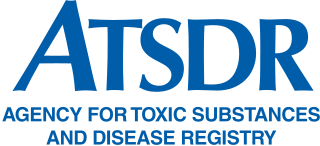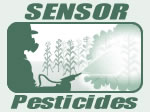
The Centers for Disease Control and Prevention (CDC) is the national public health agency of the United States. It is a United States federal agency under the Department of Health and Human Services, and is headquartered in Atlanta, Georgia.

Epidemiology is the study and analysis of the distribution, patterns and determinants of health and disease conditions in a defined population.
Chlordane, or chlordan, is an organochlorine compound that was used as a pesticide. It is a white solid. In the United States, chlordane was used for termite-treatment of approximately 30 million homes until it was banned in 1988. Chlordane was banned 10 years earlier for food crops like corn and citrus, and on lawns and domestic gardens.
The science of epidemiology has matured significantly from the times of Hippocrates, Semmelweis and John Snow. The techniques for gathering and analyzing epidemiological data vary depending on the type of disease being monitored but each study will have overarching similarities.

The Agency for Toxic Substances and Disease Registry (ATSDR) is a federal public health agency within the United States Department of Health and Human Services. The agency focuses on minimizing human health risks associated with exposure to hazardous substances. It works closely with other federal, state, and local agencies; tribal governments; local communities; and healthcare providers. Its mission is to "Serve the public through responsive public health actions to promote healthy and safe environments and prevent harmful exposures." ATSDR was created as an advisory, nonregulatory agency by the Superfund legislation and was formally organized in 1985.
A cohort study is a particular form of longitudinal study that samples a cohort, performing a cross-section at intervals through time. It is a type of panel study where the individuals in the panel share a common characteristic.

The National Institute for Occupational Safety and Health is the United States federal agency responsible for conducting research and making recommendations for the prevention of work-related injury and illness. NIOSH is part of the Centers for Disease Control and Prevention (CDC) within the U.S. Department of Health and Human Services. Despite its name, it is not part of either the National Institutes of Health nor OSHA. Its current director is John Howard.

A case–control study is a type of observational study in which two existing groups differing in outcome are identified and compared on the basis of some supposed causal attribute. Case–control studies are often used to identify factors that may contribute to a medical condition by comparing subjects who have that condition/disease with patients who do not have the condition/disease but are otherwise similar. They require fewer resources but provide less evidence for causal inference than a randomized controlled trial. A case–control study is often used to produce an odds ratio, which is an inferior measure of strength of association compared to relative risk, but new statistical methods make it possible to use a case-control study to estimate relative risk, risk differences, and other quantities.

Marine Corps Base Camp Lejeune is a 246-square-mile (640-square-kilometer) United States military training facility in Jacksonville, North Carolina. Its 14 miles of beaches make the base a major area for amphibious assault training, and its location between two deep-water ports allows for fast deployments. The main base is supplemented by six satellite facilities: Marine Corps Air Station New River, Camp Geiger, Stone Bay, Courthouse Bay, Camp Johnson, and the Greater Sandy Run Training Area. The Marine Corps port facility is in Beaufort, at the southern tip of Radio Island. It is occupied only during military port operations.
VOCs are a dangerous contaminant of groundwater, leading to groundwater pollution. They are generally introduced to the environment through careless industrial practices.
The US National Institute for Occupational Safety and Health funds the Adult Blood Lead Epidemiology and Surveillance (ABLES) program, a state-based surveillance program of laboratory-reported adult blood lead levels. In 2009, the ABLES program updated its case definition for an Elevated Blood Lead Level to a blood lead concentration equal or greater than 10 micrograms per deciliter (10 µg/dL). This chart shows CDC/NIOSH/ABLES Elevated blood lead level case definition in perspective.
Workplace health surveillance or occupational health surveillance (U.S.) is the ongoing systematic collection, analysis, and dissemination of exposure and health data on groups of workers. The Joint ILO/WHO Committee on Occupational Health at its 12th Session in 1995 defined an occupational health surveillance system as "a system which includes a functional capacity for data collection, analysis and dissemination linked to occupational health programmes".

The epidemiology of cancer is the study of the factors affecting cancer, as a way to infer possible trends and causes. The study of cancer epidemiology uses epidemiological methods to find the cause of cancer and to identify and develop improved treatments.

Sentinel Event Notification System for Occupational Risks (SENSOR)-Pesticides is a U.S. state-based surveillance program that monitors pesticide-related illness and injury. It is administered by the National Institute for Occupational Safety and Health (NIOSH), twelve state health agencies participate. NIOSH provides technical support to all participating states. It also provides funding to some states, in conjunction with the US Environmental Protection Agency.

The Gulf War syndrome (GWS) is a chronic and multi-symptomatic disorder affecting military veterans of both sides of the Gulf War (1990–1991). A wide range of acute and chronic symptoms have been linked to it, including fatigue, muscle pain, cognitive problems, insomnia, rashes and diarrhea. Approximately 250,000 of the 697,000 U.S. veterans who served in the Gulf War have enduring chronic multi-symptom illness, a condition with serious consequences.
The Camp Lejeune water contamination problem occurred at Marine Corps Base Camp Lejeune in Jacksonville, North Carolina, from 1953 to 1987. During that time, United States Marine Corps (USMC) personnel and families at the base bathed in and ingested tap water contaminated with harmful chemicals at all concentrations from 240 to 3400 times current safe levels. An undetermined number of former residents later developed cancer or other ailments, which could be due to the contaminated drinking water. Victims claim that USMC leaders concealed knowledge of the problem and did not act properly to resolve it or notify former residents.
In analytical chemistry, biomonitoring is the measurement of the body burden of toxic chemical compounds, elements, or their metabolites, in biological substances. Often, these measurements are done in blood and urine. Biomonitoring is performed in both environmental health, and in occupational safety and health as a means of exposure assessment and workplace health surveillance.
Occupational epidemiology is a subdiscipline of epidemiology that focuses on investigations of workers and the workplace. Occupational epidemiologic studies examine health outcomes among workers, and their potential association with conditions in the workplace including noise, chemicals, heat, or radiation, or work organization such as schedules.
Pesticide incidents in the San Joaquin Valley is a topic covering the justice and health issues of people living in the San Joaquin Valley resulting from the use of pesticides in the region. Pesticide use in the San Joaquin Valley began in the 1880s when certain insects were known to be causing harm in the region, much of whose economy is still based on the successful agriculture and farming of many different kinds of crops. Pesticides illnesses were reported sporadically during that time frame, but was not focused as a major issue until the post World War II agricultural boom in the late 1940s when pesticide poisonings became more widely publicized. Though Rachel Carson's Silent Spring and the use of chemicals in weapons during the Vietnam War led the federal government to pass restrictions on pesticide use, residents, primarily of low-income, have struggled with health impacts of pesticide use due to persistent over-spraying by agriculture companies working for profit.









